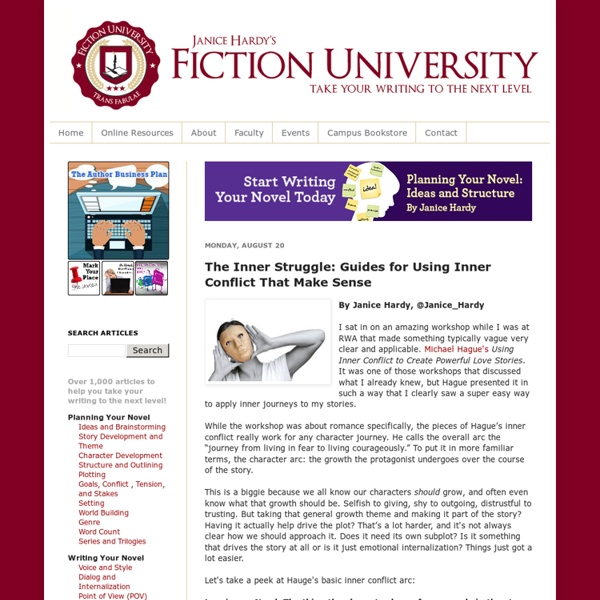Character and Characterisation in the Novel
How to write convincing characters Characterisation - the task of building characters - isn't easy. But if you're struggling to build characters with real life and vigour, just follow these rules. If you do follow them correctly, we can pretty much guarantee that your characterisation will be just fine! Know what kind of character you are writing There are roughly two types of protagonist in fiction. The second type of character (rather less common, in fact) is the genuinely extraordinary character who would make things happen in an empty room. Either type of character is fine - don't struggle to equip your ordinary character with a whole lot of amazing skills, or try to 'humanise' your James Bond character by making him nice to old ladies and interested in baking. Empathy is about story and good writing Likewise, don't worry too much if your character is likeable. A) you write well enough that your reader is drawn in to your protagonist's world, whether they like it or not; and
Character Questionnaires - Get to Know Your Characters
Receive more writing tips and advice (along with special offers and other Gotham news). One of the best ways to get to know your characters is to ask questions about them. Many writers do this as a kind of homework before they actually start writing a story. The more you know your characters, the fuller they will be. Character Questionnaire 1 This questionnaire is found in Gotham Writers Workshops Writing Fiction. You might start with questions that address the basics about a character: What is your characters name? What is your characters hair color? What kind of distinguishing facial features does your character have? Does your character have a birthmark? Who are your characters friends and family? Where was your character born? Where does your character go when hes angry? What is her biggest fear? Does she have a secret? What makes your character laugh out loud? When has your character been in love? Then dig deeper by asking more unconventional questions: Look at your characters feet.
Physical Descriptions - List of Hair Colors
Hair Color List (Note: an updated and expanded version of this list appears in my 15K-word book How to Describe Hair and Skin. See below.) [First, my profound apologies to the vast majority of readers who don't steal content, but I have to state the following. I'll admit it – hair colors are fun, even for someone like me who advocates keeping description to a minimum. Natural human hair color comes in these basic shades: blond(e), red, light brown, dark brown, black, gray, white. Don't forget about highlights! What are the nouns that apply to people with certain hair colors? Also, sometimes words pick up additional shades of meaning over time that are irrational but exist, and you won't find these connotations listed in the dictionary. Please check for frequent updates to this list! Blond – ash Blond – bronze.
Creating Stunning Character Arcs, Pt. 1: Can You Structure Characters?
What if there were a sure-fire secret to creating stunning character arcs? Would you be interested in discovering it? If you care about connecting with readers, grabbing hold of their emotions, and creating stories that will resonate with them on a level deeper than mere entertainment, then the answer has to be a resounding yes! But here’s the thing about character arcs: they’re way too easy to take for granted. 1. 2. 3. That’s character arc in a nutshell. Turns out: a lot. (Featured in the Structuring Your Novel Workbook.) The Link Between Character Arcs and Story Structure Too often, character and plot are viewed as separate entities—to the point that we often pit them against each other, trying to determine which is more important. We often think of plot as being about structure, but our notions of character and character arc tend toward the more airy-fairy. Surely, right? Wrong, actually. The three acts of the [story] correspond to the three stages of the hero’s outer motivation.
6 Ways to Make Sure Your Reader’s Brain Syncs with Your Protagonist’s Brain
photo by Andres Musta via Flickr Because here’s the thing: it’s not fiction. It’s fact. Except, you know, for the Vulcan part. And, okay, the part where you have to put your fingertips on the other guy’s face to do it. To figure that part out we had to wait for something that even ‘Bones’ McCoy didn’t have access to — fMRI technology, which revealed that when we’re really engaged in listening to a story, our brain synchronizes with the speaker’s brain – literally mirroring it. fMRI studies reveal that when we’re really engaged in listening to a story, our brain synchronizes with the speaker’s brain – literally mirroring it. In other words, we really are on the same wavelength, and their experiences become ours. The exact same thing is true when we’re reading a story. Cognitive psychologist and novelist Keith Oatley defines fiction as “a simulation that runs on the software of our minds. Exactly! In short, a story is about how the plot affects the protagonist. 1. 2. 3. 4. 5. 6.
Medieval Names - List of Medieval Names
Character Flaw Index
To make characters realistic and relatable they are given flaws, because if there is anything a writer can be sure of it is that no one in their audience will be perfect. Flaws are character traits that have a negative impact in the narrative, unless they are simply informed. They can also be exploited. See Good Flaws, Bad Flaws for a scale of flaw acceptability. Abusive Parents: Habitually violent and cruel to their own children, often because that's how they themselves were raised.
untitled



